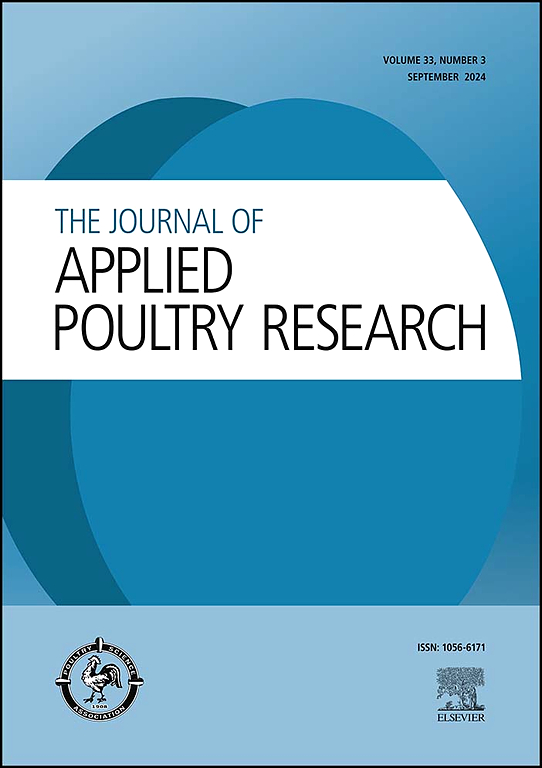Growth performance, phytate degradation, and tibia characteristics of broiler chickens fed pelleted diets with varying feed particle sizes and phytase levels
IF 2
3区 农林科学
Q2 AGRICULTURE, DAIRY & ANIMAL SCIENCE
引用次数: 0
Abstract
The objective was to investigate the effects of feed particle size and microbial phytase supplementation of pelleted diets on growth performance, myo-inositol hexakisphosphate (InsP6) degradation, and tibia characteristics in broiler chickens. Ross 308 broilers were housed in 56 floor pens in groups of 42, and seven pens were allocated to one of eight dietary treatments to measure the performance data on day 38 of age. From day 21 to 26, six birds from each floor pen were moved to metabolism units with the same distribution of treatments for digestibility and bone measurements. For the starter phase, two diets with fine or coarse particle size (429 or 657 µm mean particle size, determined after feed processing by wet sieving) were formulated and added with 500 FTU phytase/kg. For the grower and finisher phase, diets were arranged with two particle sizes (fine and coarse, 434 or 729 µm) and four phytase levels (0, 300, 600, and 1,200 FTU/kg). No significant interactions between particle size and phytase were determined. Prececal InsP6 disappearance and P digestibility were higher with fine than coarse particles, indicating that coarse grinding of rapeseed meal may not benefit birds. Increasing phytase supplementation increased ADG, ADFI, prececal InsP6 disappearance and P digestibility, tibia ash, and tibia breaking strength. Under the conditions of this study, birds were sufficiently supplied with P at a total P level of 4.0 g/kg and phytase supplementation of 1,200 FTU/kg. Renouncement of feed phosphate in the grower and finisher phase was possible without impaired performance.
不同饲料粒度和植酸酶水平颗粒饲料对肉鸡生长性能、植酸降解和胫骨特性的影响
本试验旨在研究饲料粒度和颗粒饲料中添加微生物植酸酶对肉鸡生长性能、肌醇六磷酸(InsP6)降解和胫骨特性的影响。试验选用罗斯308肉鸡,每组42只,饲养在56个地坪栏中,其中7个栏分别饲喂8种饲粮处理中的一种,测定38日龄时的生产性能数据。第21 ~ 26天,将每层围栏6只鸡移至代谢单元,按相同的处理分布进行消化率和骨测量。在启动阶段,配制两种细粒和粗粒饲粮(平均粒径分别为429和657µm,经湿法筛选后确定),并添加500 FTU /kg植酸酶。在生长期和育肥期,采用2种粒径(细粒和粗粒、434或729µm)和4种植酸酶水平(0、300、600和1200 FTU/kg)的饲粮。颗粒大小和植酸酶之间没有明显的相互作用。细粒比粗粒籽粒的前期InsP6消失率和磷消化率更高,说明粗粒对菜籽粕可能不利。增加植酸酶添加量可提高日增重、ADFI、胎前InsP6消失率和磷消化率、胫骨灰分和胫骨断裂强度。在本试验条件下,以总磷水平4.0 g/kg和植酸酶添加量1200 FTU/kg的水平,为饲粮提供充足的磷。在生长和育肥期放弃饲料磷酸盐是可能的,而不会损害生产性能。
本文章由计算机程序翻译,如有差异,请以英文原文为准。
求助全文
约1分钟内获得全文
求助全文
来源期刊

Journal of Applied Poultry Research
农林科学-奶制品与动物科学
CiteScore
4.10
自引率
10.50%
发文量
80
审稿时长
104 days
期刊介绍:
The Journal of Applied Poultry Research (JAPR) publishes original research reports, field reports, and reviews on breeding, hatching, health and disease, layer management, meat bird processing and products, meat bird management, microbiology, food safety, nutrition, environment, sanitation, welfare, and economics. As of January 2020, JAPR will become an Open Access journal with no subscription charges, meaning authors who publish here can make their research immediately, permanently, and freely accessible worldwide while retaining copyright to their work. Papers submitted for publication after October 1, 2019 will be published as Open Access papers.
The readers of JAPR are in education, extension, industry, and government, including research, teaching, administration, veterinary medicine, management, production, quality assurance, product development, and technical services. Nutritionists, breeder flock supervisors, production managers, microbiologists, laboratory personnel, food safety and sanitation managers, poultry processing managers, feed manufacturers, and egg producers use JAPR to keep up with current applied poultry research.
 求助内容:
求助内容: 应助结果提醒方式:
应助结果提醒方式:


